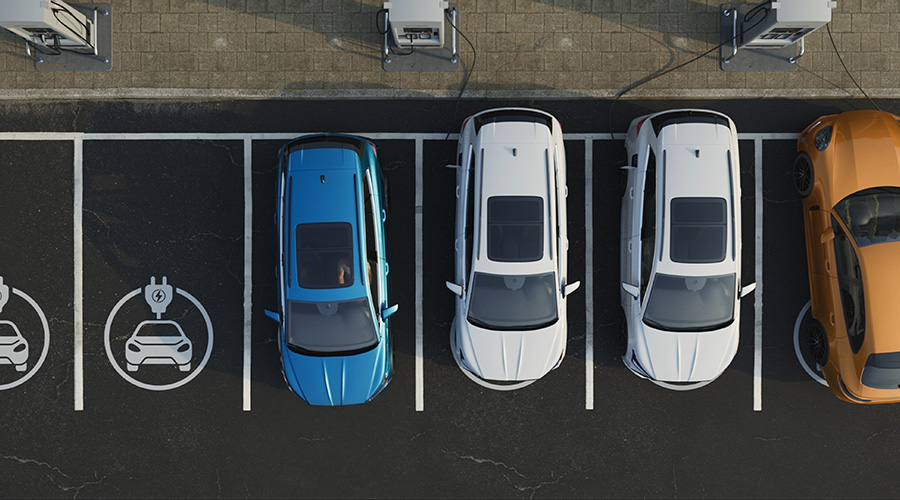Planning Electric Vehicle Charging for Employee Parking
What began as an amenity is quickly becoming an expectation, and in some jurisdictions, even a building code requirement.
By Darren Dinkelman, Contributing Writer
As electric vehicle (EV) adoption continues to accelerate, commercial building owners and operators are facing increasing pressure to provide reliable EV charging infrastructure for their employees. What began as an amenity is quickly becoming an expectation, and in some jurisdictions, even a building code requirement. However, preparing for EV charging in the workplace involves far more than just deciding where to put a few outlets.
While there is growing interest in EV charging for commercial fleets, the most momentum is in employee parking areas. Many organizations are putting in chargers so employees can top off their batteries while they’re at the office. These installations range from major corporate garages to small remote facilities with just one EV-driving employee.
Whether discussing projects for large or small clients, including headquarters, parking garages, and utility facilities, the driving force is consistent: the goal is to provide a meaningful employee benefit while staying ahead of changing regulations.
In many jurisdictions, EV infrastructure is no longer optional. Some counties now have ordinances requiring a certain number of EV chargers and EV-ready parking spaces for new builds or major renovations. These mandates and those similar are showing up across the country, prompting more organizations to take EV charging seriously, even before employee demand reaches critical mass.
Level Variety
One of the first decisions for any EV charging project is what type of charger to install. Most fall into two categories: Level 2 or Level 3.
Level 2 chargers use 208 or 240V power and are ideal for locations where vehicles will be parked for several hours, like during the workday. These can take 6–12 hours to fully charge a vehicle. Alternatively, Level 3 DC fast chargers require 480V service and can charge a vehicle in as little as 30 minutes. However, they come with significantly higher installation and operational costs.
Level 2 is the standard for most employee parking situations. It provides enough charge during the workday without the heavy infrastructure demands of DC fast chargers.
Payment Strategy
Next comes the question of how charging will be paid for. There are generally three models: Free charging, pass-through and marked up.
With free charging, the employer absorbs the cost. Pass-through pricing involves employees paying the same rate the employer pays the utility. Finally, marked-up pricing occurs where the person charging pays a higher rate and the company makes a profit.
In some offices, employees are charged the utility rate, while guests pay a premium. This helps offset costs without discouraging usage. Sometimes access is tied to employee badges or managed via mobile apps, adding another layer of control and flexibility.
Monitoring and Usage Limits
Building owners should consider monitoring tools to track power usage and charger utilization. Some want to know exactly how much power is being used or how often chargers are in use. This data can be accessed through building management systems or directly via the charger manufacturer’s platform.
Another consideration is usage limits. With a growing number of EV drivers and a finite number of chargers, some organizations implement policies to rotate access. An employee might only be allowed to charge for four hours. After that, users are notified to move their car or face idle fees. While potentially frustrating to some drivers, this approach ensures more equitable access.
Managing Infrastructure
Installing EV chargers is not just about plugging in devices. It’s about integrating them into existing infrastructure without overwhelming the electrical system. These are heavy power draws. You need to know if your building can support them, and if not, you might be looking at adding new electrical service.
Location matters too, both from a visibility and logistical standpoint. Some owners place chargers in prominent spots to showcase their sustainability efforts, while others locate them wherever power is most accessible. Either way, EV chargers take up valuable parking real estate, so coordination with operations and HR is essential.
Let the Manufacturer Help
It’s important to engage EV charger manufacturers early in the process. Each brand has slightly different features. Some manage their own billing and data plans, which can save the building owner from having to deal with individual phone or payment systems. While manufacturers often charge service fees, they also simplify what could otherwise be a complex management task.
As the shift to EVs continues, companies that proactively plan for charging infrastructure are positioning themselves as forward-thinking employers and smart building operators. It’s not just about charging cars. It’s about future-proofing your facility, staying compliant with emerging codes, and offering a benefit that employees are starting to expect. For facilities professionals, the EV transition is already underway. The time to plan is now.
Darren Dinkelman is an electrical engineer at McClure Engineering, a mechanical and electrical consulting engineering firm dedicated to the development of innovative solutions to unique engineering problems.
Related Topics:












